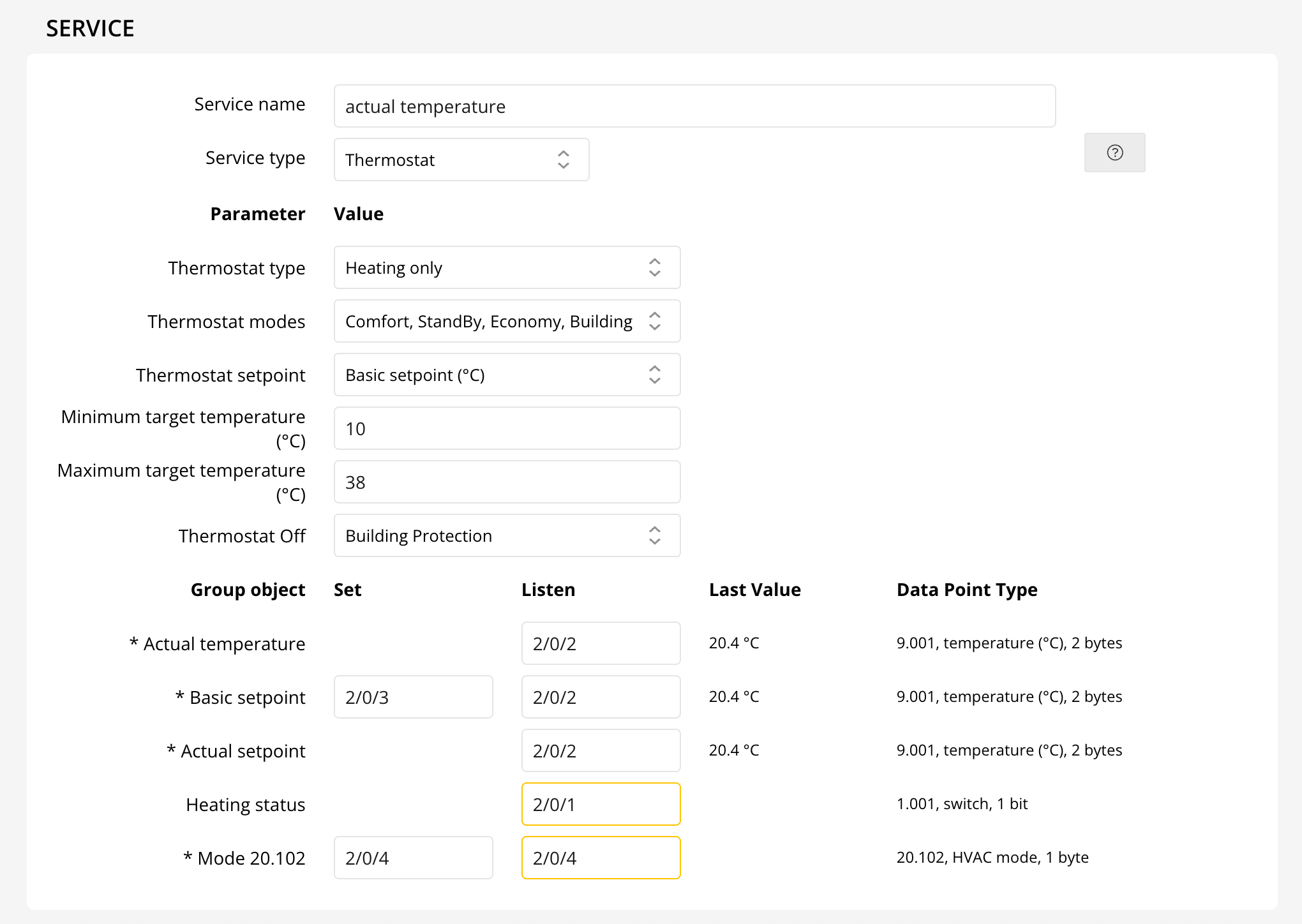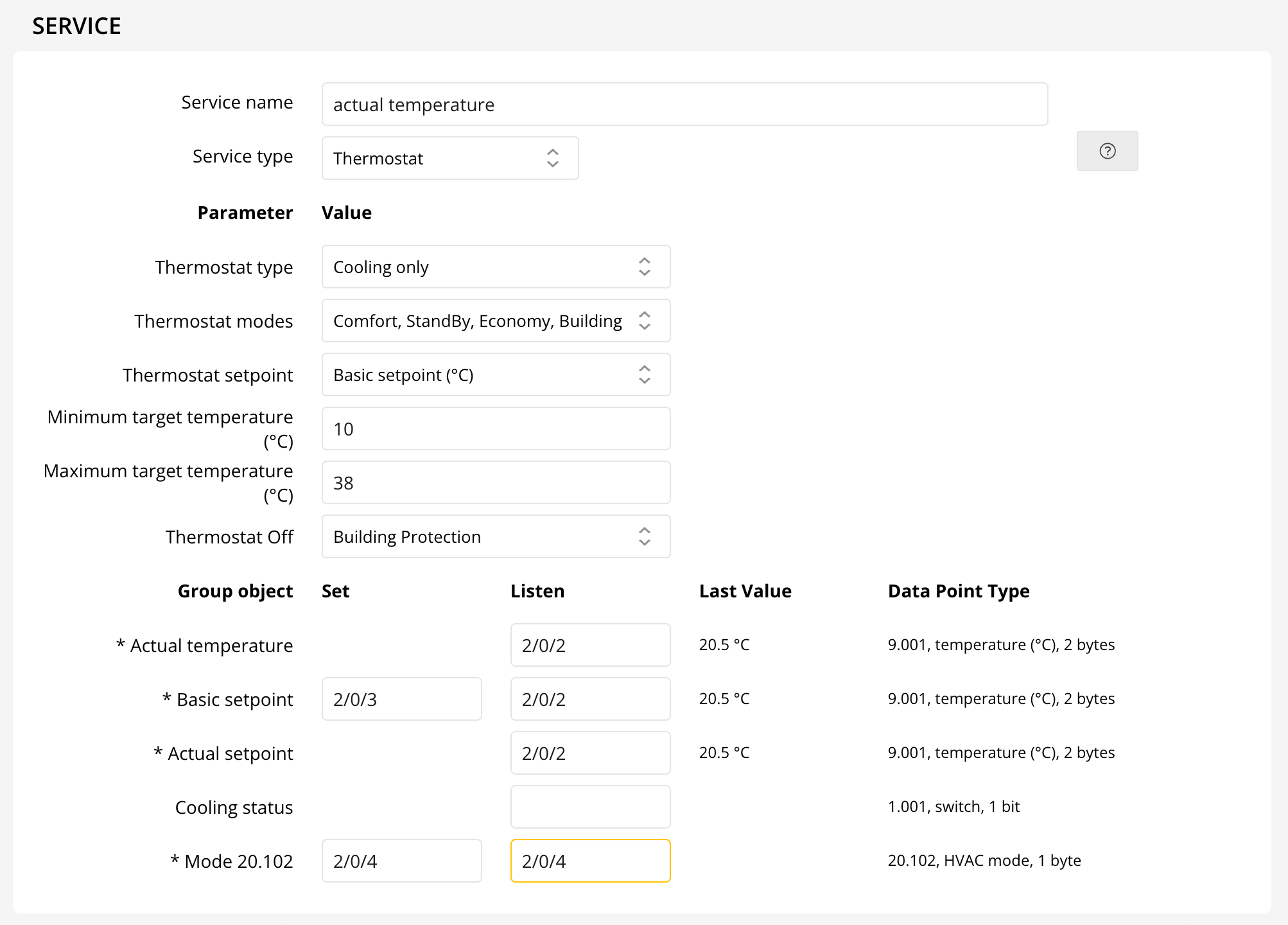
First of all we support 3 thermostat modes; Heating Only, Cooling Only, Heating and Cooling
As the name implies that this mode only supports Heating. Here is a screenshot which shows a basic configuration for Heating Only

Heating status is a 1-bit value that reports whether the heating is currently running or not.
As the name implies that this mode only supports Cooling. Here is a screenshot which shows a basic configuration for Cooling Only

New group object appears which is Cooling Status. It is again 1-bit value that reports whether the cooling is currently running or not.
This mode supports both Heating and Cooling. Here is a screenshot which shows a basic configuration for Heating and Cooling

You need to select whether switching between the heating mode or cooling mode is manual or automatic.

If Manual mode is selected then you should fill listen and set group addresses for the Heating/cooling mode group object.

You can also fill both Heating status and Cooling status.

We have 4 type of HVAC modes

It could be "None", "On, Off", "Comfort, StandBy, Economy, Building Protection" or "Auto, Heat, Cool, Off"
If it is chosen "On, Off" then you should fill the set and listen group addresses for On/Off group object. These group addresses are used for controlling turning on/off the thermostat. This is very basic/simple mode for the Thermostats

Besides "On, Off" mode, there are also two other more advanced modes we support "Comfort, StandBy, Economy, Building Protection (DPT 20.102)" or "Auto, Heat, Cool, Off (DPT 20.105)"
"Comfort, StandBy, Economy, Building Protection" mode is mainly for thermostats and supports Comfort, StandBy, Economy and Building Protection modes. You should fill the set and listen group addresses for the group object "Mode 20.102"

"20.105" mode is mostly used for Airconditioning and supports the Auto, Heat, Cool, Off modes. Since this mode already contains Off, Heat and Cool in itself, Thermostat Off and Heating/cooling switchover parameters become invisible so that you do not need set them anymore

This configuration option determines how to adjust the thermostat setpoint.

Either the thermostat's basic setpoint can be adjusted directly or the setpoint can be shifted. When shifting the setpoint you need to select whether the setpoint can be shifted by a temperature difference or by using a counter value. The counter value is multiplied by the setpoint shift steps in the KNX thermostat to determine the actual adjustment. Ensure that the step size matches the configuration in the KNX thermostat's parameters.
These values determine the available values in the Home app when adjusting the thermostat. They may differ from the allowed values in the thermostat.

Actual Temperature
It is used to show the current temperature in the room
Basic Setpoint
It controls the basic setpoint of the thermostat
Setpoint shift
It controls the setpoint shift of the thermostat
Actual setpoint
It is calculated by the thermostat based on the basic setpoint, setpoint shift, operating mode, and/or heating cooling
Heating message (optional)
It is a 1-bit value that reports whether the heating is currently running or not. When you system is heating this will show in the Home app as "Heating to X°" and the icon will turn orange.
Cooling message (optional)
It is a 1-bit value that reports whether the cooling is currently running or not. This will show in the Home app as "Cooling to X°" and the icon will turn blue.
Mode 20.102 (optional)
It is used to control the 20.102 HVAC mode
Mode 20.105 (optional)
It is used to control the 20.105 HVAC mode
Heating/cooling mode
It allows Thinka to switch between heating or cooling
On/Off
It allows to turn or off the thermostat
Notes
Thinka has multiple configuration options, mostly optional, for controlling thermostats. The most simple version of a thermostat is one where you can only set the target temperature. Use a temperature sensor when you only want to be able to read the actual temperature.
For detailed information of the specific home apps, please see the links Apple Home, Google Home, Alexa